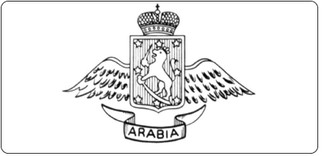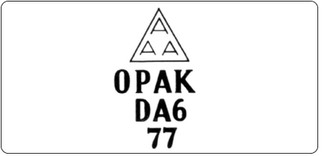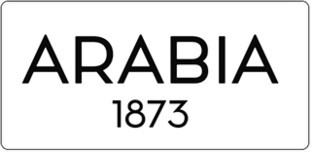Arabia Factory Stamps

Arabia's one hundred years history includes countless numbers of dish models and designs. Each item has it's own place in the history.
The bottom stamps have an important role when identifying the age of dishware. The original purpose of stamping is unclear. It might come from the silver and tin dishware times when master craftsmen marked their products with their own stamps. Also it might have signified the factory warranty, like it's understood nowadays.
Arabia's 1-quality production is stamped with a body pressed stamp or with a color stamp. Instead of stamping some hand painted items have singed with Arabia text and initials of the designer and the painter. The search might not result all items, but it gives an overview. We are developing the service. If the search doesn't give any results, it means we currently don't have it on sale.
The bottom stamps have an important role when identifying the age of dishware. The original purpose of stamping is unclear. It might come from the silver and tin dishware times when master craftsmen marked their products with their own stamps. Also it might have signified the factory warranty, like it's understood nowadays.
Arabia's 1-quality production is stamped with a body pressed stamp or with a color stamp. Instead of stamping some hand painted items have singed with Arabia text and initials of the designer and the painter. The search might not result all items, but it gives an overview. We are developing the service. If the search doesn't give any results, it means we currently don't have it on sale.

1. 1874 - 1890

2. 1874 - 1930
The oldest of Arabia's factory mark was stamped in the body. It was used between 1874-1890. A letter signifying the type of body might be placed above or below the factory mark.
~ Check Out - Products with this Stamp ~
~ Check Out - Products with this Stamp ~
A variant of the oldest factory mark is also stamped in the body. Beside the factory mark, a letter was used to indicate the body and from 1899 on, numeral code was given to indicate the year and month of manufacturing.
~ Check Out - Products with this Stamp ~
~ Check Out - Products with this Stamp ~

3. 1874 - 1882

4. 1880 - 1890
During the first years of Arabia 1874-1882 factory mark was stamped in the body.
~ Check Out - Products with this Stamp ~
~ Check Out - Products with this Stamp ~
Between years 1880 - 1890 the factory mark was stamped in the body and only a few plate models were stamped. Cobalt, black, blue, green, lilac or the color of the pattern.
~ Check Out - Products with this Stamp ~
~ Check Out - Products with this Stamp ~

5. 1880 - 1901

6. 1878 - 1910
The first colored mark was used between 1880-1910. Black, blue or green.
~ Check Out - Products with this Stamp ~
~ Check Out - Products with this Stamp ~
Colored mark that was used in stamping dish sets and staple goods between 1878 - 1910. It was also used in exports. Black, green, blue, lilac or color of the pattern. The coat-of-arms of Finland is located in the centre.
~ Check Out - Products with this Stamp ~
~ Check Out - Products with this Stamp ~

7. 1880 - 1910

8. 1890 - 1910
Cobalt, black, blue, green, lilac or the color of the pattern, used between 1880-1910.
~ Check Out - Products with this Stamp ~
~ Check Out - Products with this Stamp ~

9. 1890 - 1910

10. 1890 - 1910

11. 1893 - 1917

12. 1893 - 1907
Colored stamp for dish sets and staple goods between 1893 - 1917.
~ Check Out - Products with this Stamp ~
~ Check Out - Products with this Stamp ~
Factory stamp used between 1893 - 1907. Both colored stamp and stamp in the body were used. Opak was Arabia's faience quality. The word Opak comes from Latin and means opaque.
~ Check Out - Products with this Stamp ~
~ Check Out - Products with this Stamp ~

13. 1897 - 1907

14. 1897 - 1907
Usually stamped in the body, rarely colored stamp. Between 1897 - 1907.
~ Check Out - Products with this Stamp ~
~ Check Out - Products with this Stamp ~
Factory mark stamped in the body, different type of number combinations were used simultaneously between 1897 - 1907.
~ Check Out - Products with this Stamp ~
~ Check Out - Products with this Stamp ~

15. 1900 - 1920

16. 1900 - 1920
Factory mark between 1900 - 1920. Usually colored stamp. Blue, black or brown.
~ Check Out - Products with this Stamp ~
~ Check Out - Products with this Stamp ~
Colored stamp between 1900 - 1920. It is not known why two slightly different types of factory marks were used at the same time.
~ Check Out - Products with this Stamp ~
~ Check Out - Products with this Stamp ~

17. 1900 - 1917

18. 1917 - 1927
Factory mark for exports between 1900 - 1917. Black, blue or gold.
~ Check Out - Products with this Stamp ~
~ Check Out - Products with this Stamp ~
Colored stamp, which was adopted after Arabia had passed into Finnish ownership. Between 1917 - 1927. Black, blue, brown, cobalt or gold. An abbreviation from Arabia Porsilnsfabrik Aktiebolag.
~ Check Out - Products with this Stamp ~
~ Check Out - Products with this Stamp ~

19. 1917 - 1927

20. 1928 - 1932
Mark used in exports between 1917 - 1927.
Black, blue, brown or gold.
~ Check Out - Products with this Stamp ~
Black, blue, brown or gold.
~ Check Out - Products with this Stamp ~
In 1928 the abbreviation APA (Arabia Porslinsfabrik Aktiebolag) in the factory mark was replaced with AAA (Arabia Aktiefabrik) abbreviation. In use until 1932.
~ Check Out - Products with this Stamp ~
~ Check Out - Products with this Stamp ~

21. 1923 - 1949

22. 1949 - 1964
Stylish sketch of Arabia's first tunnel kiln as a colored stamp between 1932 - 1949. Brown, green or gold. The mark signifies Arabia's new, at that time the world's largest, 122 meters long, tunnel kilns. The mark is known as a "pipe stamp".
~ Check Out - Products with this Stamp ~
~ Check Out - Products with this Stamp ~

23. 1949 - 1964

24. 1964 - 1971
Export mark from 1949 - 1964 was also used for the home market items. Also known as the "crown stamp". The numbers in the stamp are the factory's own production codes, they do not indicate the production year or month.
~ Check Out - Products with this Stamp ~
~ Check Out - Products with this Stamp ~
Home market and export mark between 1964 - 1971.
Known as the "crown stamp".
~ Check Out - Products with this Stamp ~
Known as the "crown stamp".
~ Check Out - Products with this Stamp ~

25. 1971 - 1975

26. 1975 - 1981
Year 1971, the introduction of the factory brand in both domestic and export products.
Year 1975, the introduction of the factory brand in both domestic and export products.

27. 1982 - 2014

28. 2015 -
The factory mark for the year 1982-2014.
The current factory mark.

